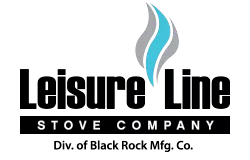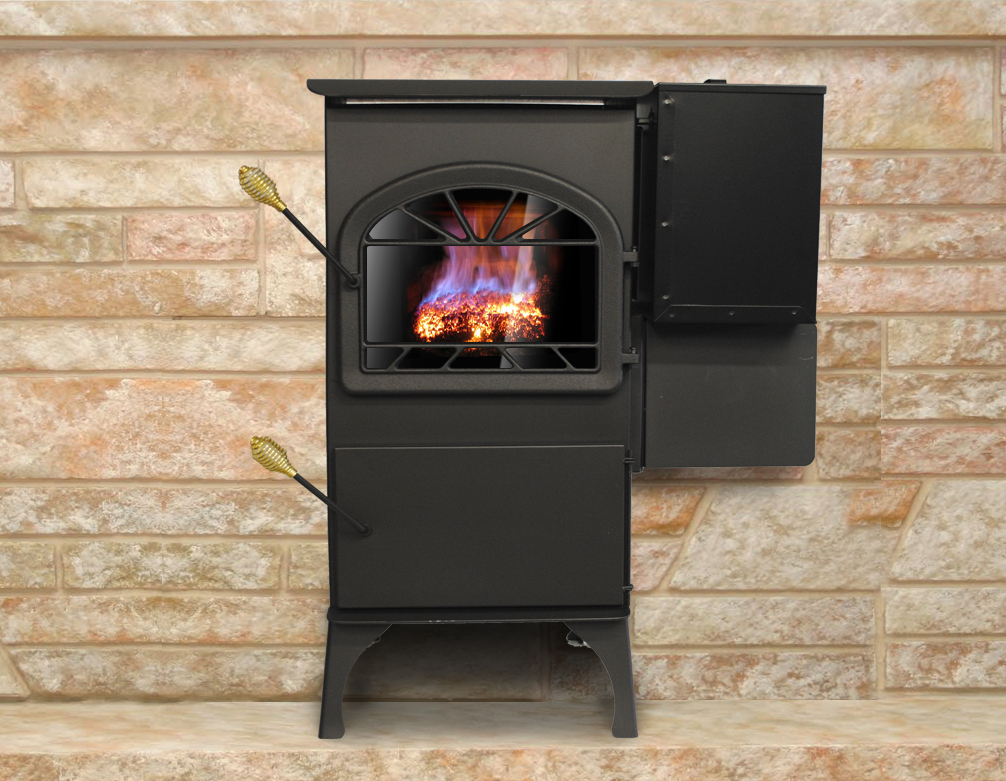Using anthracite for heating in American homes started rising in popularity in the 1850s when mining practices were improved and people realized that it produces higher heat levels than wood. Anthracite Coal produces more BTUs per pound, is easier to handle, and is smokeless. To this day, many American households use anthracite for stoves, furnaces, and boilers to keep warm for less cost.
Given the growing demand for anthracite as a residential fuel and heat source, educating people on the proper handling of anthracite-burning equipment becomes more crucial. Using it has many benefits, but it comes with a few drawbacks that everyone must keep in mind. For instance, anthracite has a fairly high ash content which is corrosive when exposed to moisture. It can be more challenging to get anthracite to ignite than wood, especially for first-time users. Carbon monoxide is the biggest safety issue for any heating appliance that burns fuel. Proper detection of carbon monoxide is of utmost importance and should be understood fully. It is also extremely important that the installation, operation, and maintenance of any stove comply with the manufacturer’s instructions and specifications. This safety guide will provide some pertinent safety facts to help with the selection, installation, operation, and maintenance of an anthracite-burning stove. While the safety practices for central heating units (furnaces and boilers) are similar, we will address stoves only in this safety guide.
Types of Anthracite Stoves
Before looking for the best coal stove for your home, you need to know the available types and differences. You can choose between hand-fed anthracite stoves and stoker anthracite stoves. They differ in function and operation, and each has its pros and cons. What you pick will depend on your lifestyle, preference, and need.
Hand-Fed Anthracite Stove
A hand-fed or hand-fired anthracite stove requires manual operation for loading fuel and regulating heat output. It works similar to wood stoves, wherein you need to load the anthracite and tend to it as the fuel load starts to burn off. The hand-fed stove will have a cast iron grate system that holds the anthracite and allows air to pass through underneath. The ash pan on a hand-fired stove tends to be smaller than on a stoker since the shaker mechanism used to grind up the embers makes finer ash. The operation of this kind of stove is somewhat an art rather than a science. It requires a bit of a learning curve to get maximum burn time. This type of stove is an excellent match for those who desire to live off the grid since they do not need electricity to run and always vent into a chimney.
Stoker Anthracite Stove
A stoker anthracite stove is your go-to if you have a busier lifestyle and will not have the time to check on your fire multiple times in 24 hours. It is an automatic burning unit that requires less tending, thanks to an automatic feed that will load anthracite into your fire as determined by a control system. You can adjust the loading frequency and heat output depending on the type of control system. Leisure Line uses the Coal-Trol system which automatically controls fuel feed and convection fan speed depending on the temperature setting and heat loss in the space heated. This allows control in the space to plus or minus one degree Fahrenheit. Another benefit of a stoker is that venting into a chimney is optional; they can be direct-vented through sidewalls or power-vented. The only drawback to stoker stoves is that they need electricity to run since they are automated, so they are virtually useless without a backup power supply when the power goes out.
Anthracite Stove Installation
Most homeowners install their anthracite stove themselves. However, it is always best to check with local building code authorities and your insurance company before installing a stove. Of course, professional installation is one way to ensure that the job is done right. One of the most common repercussions of misguided installation is improper venting, which could lead to carbon monoxide release in the home or, even worse, personal injury and property destruction.
As with any home project, proper planning is very important. The first thing to consider is your space. Do you have a large area that you wish to heat, or are you focusing on a single room in the house? The size and capacity of your anthracite stove should reflect your answer to that question. Location selection is also dependent on how it will be vented. If direct or power vented, it will need to be on an outside wall. If it vents into an existing chimney, it will need to be located nearby, and the chimney must be inspected for suitability for the application. Heating from the basement vs. in the living space will also help determine size. If a chimney is going to be installed, this should be accomplished first to ensure the planned location is feasible.
A proper hearth pad is required to ensure the stove sits on non-combustible materials. The manufactures requirements, as well as local codes, must be followed to ensure a safe installation. There is also a minimum coverage for the hearth pad at the front of the stove, usually 16″. Other considerations are power outlets if required, and clearance from the stove to combustible materials. Each manufacturer provides a label on the stove per UL 1482 to show minimum clearances. Also, consider where the fuel will be stored to ease loading and minimize any dirt or dust created by handling. Obtaining an extra ash pan is always a good idea. This allows one to cool before the ash is emptied.
After the installation is complete, verify that your insurance company and/or local code officials perform any required inspections. This must be accomplished before the stove is placed in operation. Proper Carbon Monoxide detectors must be placed outside of all sleeping areas and at least one in the vicinity of the stove. Document the installation date and set a reminder for battery replacement annually if equipped. Also, most CO detectors last only five years; set a reminder for a replacement to ensure the safety of you and your loved ones. Before the operation, it is also important to discuss safety procedures with the family/residents in the heated space. There should be clear instructions for evacuation in the event of a CO detector alarm and a designated marshaling area so a full accounting of everyone can be accomplished.
Anthracite Stove Operation
The operating manual must be reviewed thoroughly before lighting your anthracite stove. anyone who will be loading fuel or taking out ashes should be fully briefed on all required actions and safety precautions. Materials for lighting the stove should be kept in a secure location away from the stove. Likewise, the area around the stove should be kept clean and free from debris.
Check CO detectors for proper operation before lighting your stove and verify the batteries have been replaced in the past year. Also, test any safety devices utilized for direct and power vents; these interlocks are provided to shut the stove down in the event of a low draft. The flue piping should be inspected to ensure no leaks and that it is in good condition. Additionally, the gaskets on stove doors and other critical areas should be inspected to make sure they are in serviceable condition. Likewise, the glass on the top door if so equipped should be inspected for cracks and any indication it is in need of replacement.
Anthracite burning stoves must only be loaded with anthracite coal. The use of bituminous, lignite, or sub-lignite is dangerous and ill-advised. Aside from the safety considerations, anthracite is more energy-dense and cleaner burning than any other kind of coal. Also, wood pellets or any bio-mass fuel is not to be burned in an anthracite burning stove unless the manufacturer specifically allows it. Burning these fuels will result in a hopper fire, which can be very dangerous and possibly life-threatening.
Once lit, ensure that the stove is in a safe place and away from any possible contact by children or pets. If the stove is new or recently painted, open the windows to allow any smoke produced by curing the high-temperature paint to escape. Surfaces of an anthracite-burning stove can reach up to 700* Fahrenheit so proper gloves should be worn during loading and ash removal operations. Also, it may be advisable to place some kind of barricade around the stove to prevent incidental contact. Ensure that any such barricade is non-flammable and stands on its own with little chance of being knocked over.
Anthracite Stove Maintenance
Proper stove maintenance will ensure a safe and efficient operation for years to come. All stoves tested to be in compliance with UL 1482 are required to come with an installation and maintenance manual that meets UL 1482 requirements. This means that the instructions will include all pertinent facts to ensure safe operation and should be followed. A complete review of the manual and any supporting documentation should be done on a regular basis. Leisure Line has a YouTube Channel with many helpful videos and maintenance tips.
All venting system piping and components must be cleaned annually and inspected. The interior and exterior of the stove will need to be cleaned and coated with a metal protective agent such as WD 40 or equivalent. Most metal protective coatings are flammable, so ensure there is proper ventilation and no open sparks or flame during application. All working parts such as fans, coal feed mechanisms, and controls should be disassembled, cleaned, and lubricated. Anthracite ash is corrosive when exposed to moisture. The stove should be disconnected from outside air sources, and if possible, a 40-watt incandescent light bulb should be placed inside to keep away corrosion.
Since there is no creosote buildup from burning anthracite, the chimney, if used, will need cleaning and inspection once every 2 to 5 years. Also, don’t forget about changing the CO and smoke detector batteries.
Conclusion
Always follow all manufacturers’ instructions for installation, operation, and maintenance. The safety tips provided in this article are meant as a start for your education on the safe operation of your anthracite stove. It is up to you to remain curious and always try to learn more to ensure maximum safety. If this is done, your experience with an anthracite-burning stove will be safe, efficient, and easy. They are cost-effective solutions for household heat management, and all their benefits offset the learning curve required for proper usage and maintenance.
Leisure Line Stove Company manufactures top-of-the-line anthracite coal stoves, boilers, and furnaces that put your satisfaction at the forefront! All our products are of automatic feed stoker design, combined with the Coal-Trol system. They require minimum effort and maintenance to keep you cozy and warm. Give us a call at 570-752-1811 to discuss your needs and learn more about our solutions for your heating needs!



